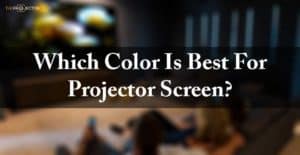 Do you ever feel like you can’t make up your mind about Which Color Is Best For Projector Screen?
Do you ever feel like you can’t make up your mind about Which Color Is Best For Projector Screen?
We’ll look at some of the best colors to use for projection screens and why. And also, we’ll discuss the pros and cons of different colors and help you decide which is best for you.
Choosing the right color for your projector screen can make all the difference in how your presentation or movie looks.
Whether you’re a first-time projector user or someone using them for years, keep reading to learn more about the best colors for projector screens.
which color is best for projector screen?
How many colors are on a projector screen?
Typically, three colors are used for projector screens: white, gray, silver, and black. Each of these colors has its own advantages and disadvantages.
White Projector Screen
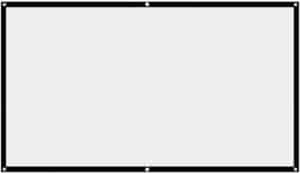
The industry-standard white screens became a hit when projectors’ prominence was used in several places and for several purposes.
The white color is a popular choice for projector screens due to its ability to provide accurate colors and bright light. This makes it ideal for watching movies, TV shows, or presentations in well-lit environments.
There are two main types of screen materials used on white screens: matte fabric or the standard vinyl with PVC material. The PVC material creates an illumination effect that blends and diffuses with light.
This hides image flaws from a video or presentation, similar to the reflection seen on a regular monitor or HDTV. The color white also highly affects the Contrast of the projected image, giving users a realistic display with bright colors.
White screens are common and mostly recommended for environments with full lighting control. The bright light from a projector can cause images to be projected on surrounding walls, so users need to keep the room very dark to get the best picture quality.
Gray Projector Screen
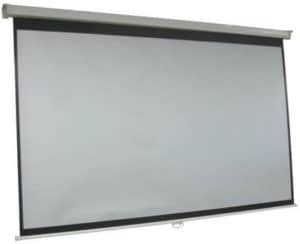
Gray screens are projection screens typically used in home theaters and other settings where the ambient light cannot be controlled. Unlike traditional white projector screens, which create sharp contrast images, gray projector screens produce more muted colors and tones.
While gray projector screens do have some drawbacks – such as the tendency to make everything appear grayish – they can be a good option for those who want the best of both worlds: the enhanced Contrast and sharpness of a black screen, with the more muted colors and tones of a white screen.
Gray projector screens are known for absorbing light pollution in a room. They’re great for those who experience having a difficult time controlling ambient light. These screens are also great for any who need a cost-effective alternative while also using a bright projector (one with a high brightness rating).
Black projector screen
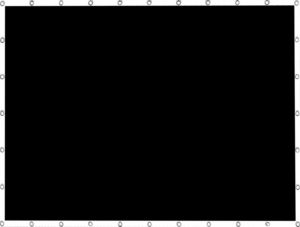
A black screen is a screen that is designed to absorb light rather than reflect it. This makes it ideal for projecting images in a dark room, as it will not wash out the picture as a white screen would.
Black projector screens are also more effective at contrast than other screen colors, and this means that they will make black and white images appear sharper and more defined. If you plan to watch many movies or TV shows on your projector, then a black projector screen is a perfect choice.
Black projector screens are also great for providing deeper blacks that gray or white screens.
Silver projector screen
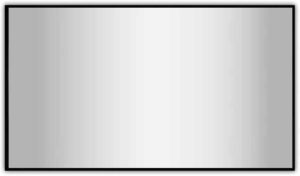
The term ‘silver screen‘ is associated with the early days of the cinema, when silver screens were commonly used. Silver screens were used to provide the best possible brightness and detail, allowing viewers to fully appreciate films and images.
Today, silver projector screens are still available, but they are more expensive than other types of projector screens. If you want the classic cinematic experience and have the budget for it, then silver screens are the way to go.
Silver screens were used to enhance and reflect the little light that was shown by the weaker projectors of the past. They allowed low-light projectors to to project images as strongly as they possibly could.
- The difference between silver screens and white and gray ones: Unlike in grey screens, silver screens make contrast and whites pop off the screen as with the vividness of black and white photographs. This effect is doubled in films with color. Silver is considered the best of both worlds when it comes to the high contrast in gray and the color fidelity of white, by offering better detail perception and depths of blacks and whites as well as showing every color in the spectrum.
- Silver screens enhance gain: Back in the day, cinemas showed talkies and movies. Silver screens were used to enhance the gain of the low-light projectors of the past to as high as a gain of 10 compared to the gain given by white screens. This type of projector screen enhances brightness.
- Issues of hot spotting: While grey and white screens are made in a way that reduces hot spotting , silver screens shine a bit, and will show hot spotting. To prevent hot spotting, one should find a surface that provides the properties of silver screens with the diffusion given by white screens.
- Advancements in silver screens: Silver, while being thrown away for white and grey screens in the past, has been making a comeback as there are new technologies that provide emulsion or surfaces with the properties of silver while giving decent light diffusion that prevents hot-spotting.
Which Projector screen color is best?
All projector screens have their own advantages and disadvantages, so it depends on what you want from your screen. If you need a screen that can provide accurate colors and bright light, then a white screen is the best choice.
If you need a screen that can provide enhanced Contrast and sharpness, then a black screen is the best choice. And if you want the classic cinematic experience, then a silver screen is the ideal option.
Below you’ll find the projector screen colors and their uses:
- Gray: Gray screens are called high contrast screens because they are made to enhance contrast on digital projectors in viewing rooms with ambient light. Gray screens absorb the ambient light that strikes it better than white screens do. By doing this, the black levels are maintained. This works by assuming that the projector has ample brightness (lumen) output, and white are allowed to remain white while the blacks are maintained as deeper levels.
- White: White makes logical sense as a projector screen color since it reflects light well and won’t alter the image projected. There are a few problems that come with using a white screen. For starters, they reflect light onto nearby ceilings or walls. Reflecting said light means you’ll need a powerful lamp so you can get a bright, clear image (unless you decide to make the room completely dark). It’s also difficult to get high contrast images. Deep blacks are known to be difficult to produce with projectors anyway but white screens only make it more difficult.
- Silver: Silver projector screens have the highest gain out of all projector screen colors – this aids in combatting washout and brightens images.
- Black: Black screens are known for being better at producing darker portions of the image. This makes the image have better visibly better contrast. Black screens also don’t result in higher light reflection and work better in rooms that have ambient light. Not only that but they also make bright colors look a bit better. While this may seem counterintuitive, it has something to do with contrast. Think about it the way you would think about writing with yellow chalk. While the marks would be difficult to see on white paper, it would be clearly visible on a black chalkboard.
Does the projector screen matter?
Yes, a projector screen matters a great deal when projecting high-quality images or videos. Different types of screens offer different brightness levels, Contrast, and other visual effects.
Factors like ambient lighting also need to be considered when choosing a projector screen. Ultimately, the best choice will depend on your specific needs and budget.
Can I paint my projector screen?
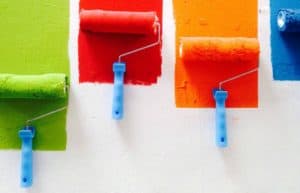
This is a question that many projector screen users may ask themselves at some point or another. The answer depends on the type of screen you have and its material and construction.
For example, if you have a white projector screen made from PVC materials, it would likely be possible to paint it with certain types of paint. However, if you have a black projector screen made from non-PVC materials, painting it would be much more complex, and the results would likely be less than satisfactory.
Ultimately, the best way to determine whether or not you can paint your projector screen is to consult with the manufacturer or an expert. They will be able to advise you on the best course of action based on the specific type of screen you have.
How do you paint a projector screen you ask?
- First you have to turn the projector on and synchronize the image to the screen. You want to project focused images with an image size of your choosing. Also, make sure the image you use is bright and is using the right contrast ratio.
- Next, using tape, map out the edges of the image. You’ll want to check for any errors, making sure the the rectangle is straight and not bent on any side.
- Now, choose the to paint on the outside of the paint or to paint only on the inside of the paint. If you decide to paint outside the tape, only use black paint for the area.
- Pour the paint into the bucket – if you decide to mix colors make sure to mix them inside the bucket before pouring them into your paint tray.
- Take a bit of paint using the roller, make sure you use a near perfect amount of paint. If you use too little paint it won’t sufficiently cover the areas and if you use too much paint it will drip and lump up when it dries.
- Make a double coat. You’ll have to wait for the paint to dry off before the second coat is applied – again, make sure to not apply to little or too much paint.
- Remove the tape before the paint dries. If the tape is removed after the paint dries, it will crack at the edge of the paint.
Can I use a wall as a projector screen?

It is possible to use a wall as a projector screen, but some factors to consider before making this decision. For example, the wall needs to be smooth and free of any text or designs that can distract from projected images or videos.
The wall also needs to be a light color, such as white, for the best results. If the wall is too dark, it will absorb too much light, and the image quality will suffer.
Another factor to consider is the size of the wall. It needs to be large enough to accommodate the projector’s image without being so large that the image appears fuzzy or distorted.
side note: Screens don’t reflect light as well as projector screens and there are divets in the wall that may change (for the worse) the quality of the image.
Screen VS Wall Paint, which one is best?
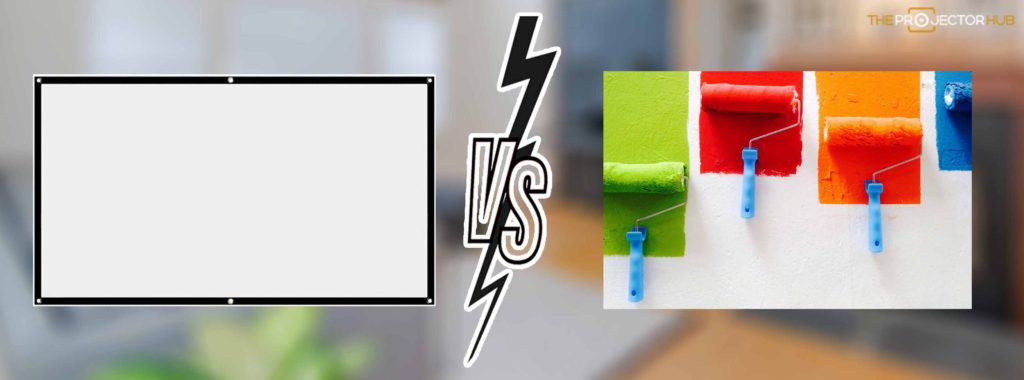
It is always better to buy a proper projector screen with all the accessories instead of compromising your viewing experience. With the cost of projectors being high, most people choose to use white walls instead of a projector screen.
However, while this may seem like the cheaper and easier option in the short term, a proper projector screen will actually provide you with a better viewing experience for a long time.
Projector screens have optical coatings that enhance their reflective properties, while walls tend to have bumps and ridges that can cause light to be reflected unevenly.
Furthermore, projector screens are specifically designed for use with projectors, optimized to offer the best possible image quality and viewing experience.
For these reasons, it is generally recommended that you choose a projector screen rather than relying on a wall as your projector screen.
However, if cost or space constraints make this impractical, you may still be able to enjoy some benefits by carefully choosing the wall area you use. For example, a wall with a smooth, white surface will provide a better image than a wall with many textures or patterns.
The best way to enjoy your projector is to use a proper projector screen when it comes down to it. This will provide you with the best image quality and viewing experience, making it well worth the investment.
However, if you are on a tight budget or have limited space, using a carefully chosen wall area can still provide some benefits. Just be sure to avoid using areas with lots of textures or patterns, as these will cause distracting reflections and uneven illumination.
Which screen color is best for the outdoors?
The best screen color for the outdoors is white. This is because white reflects light better than any other color, so it will be easier to see the image or video being projected outdoors.
When choosing a screen color for outdoor use, other factors include reflectivity, brightness, and durability. A white screen will generally be more reflective than a darker color, so it will be easier to see the projected image under bright sunlight or other strong light sources.
Which Color Is Best For Projector Screen: The Bottom line
The best color for your projector screen depends on your specific needs and preferences. However, we hope this article has helped you better understand the pros and cons of different colors and given you a few ideas about which might be best for you.
